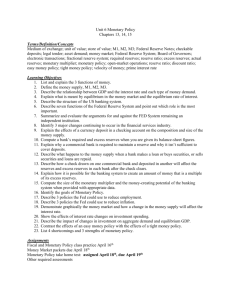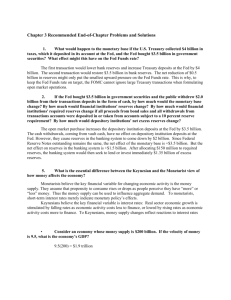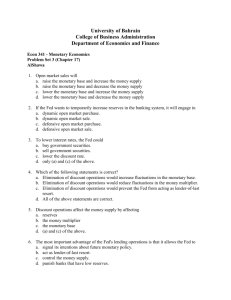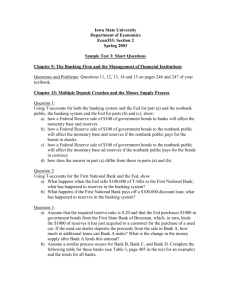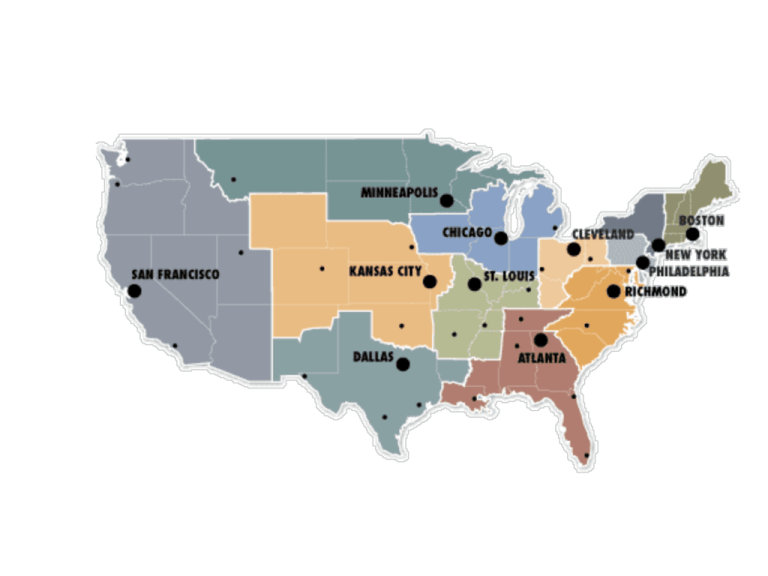
Monetary Policy
• Who controls monetary policy?
• What is monetary policy?
• How does monetary policy work?
Who controls monetary
policy?
• In the U.S., the Federal Reserve (the Fed),
which is the central bank of the U.S.
• Many other countries have central banks
• They vary in how much independence they
have from the rest of the country’s
government
• A central bank generally controls the supply of
reserves in the country’s banking system
Who controls monetary
policy? (cont.)
• The Federal Reserve system was created on Dec. 23,
1913, by an act of Congress
–
–
–
–
seven-member Board of Governors serving 14-year terms
two members serve as Chair and Vice-Chair (4-yr terms)
twelve Reserve Banks
twelve-member Federal Open Market Committee (FOMC),
comprised of the Board plus five Reserve Bank presidents
– The President of the Federal Reserve Bank of New York is
always on the FOMC
• The FOMC carries out open market operations, which
is a main component of monetary policy
What is monetary policy?
• The actions of the government or central bank in
affecting the level of the money supply
• Monetary policy is often used explicitly to influence
the level of aggregate demand and thus national
income/real output
• This occurs indirectly through manipulation of the
market for bank reserves thus affecting money supply,
thus affecting interest rates, thus affecting investment
• Keep in mind that money supply is a stock, while
national income/real output is a flow
What is monetary policy?
(cont.)
• Three main tools of monetary policy
– reserve ratio requirements
– the discount rate
– open market operations
• Open market operations are the most frequently
utilized
• All three of these tools affect bank reserves
The market for bank reserves
• Required reserves = rr x Deposits, where rr is the
required reserve ratio
• The supply of reserves comes from the Fed and from
banks with excess reserves
• The demand for reserves mostly comes from banks
who are currently below their required ratio
• Two “prices” in the market
– the discount rate (for loans of reserves from the Fed)
– the federal funds rate (for interbank loans of reserves)
Open market operations
•
Open market operations are when the Fed
buys and sells government securities (bonds)
on the open market
– it pays for these securities by creating new bank
reserves
– this increase in bank reserves lowers the federal
funds rate
– the Fed normally has a target rate for federal
funds, set by the FOMC
Open market operations
•
Suppose the Fed buys securities:
– this creates new bank reserves
– this decreases the federal funds rate and increases
the quantity demanded of bank reserves
– this expands bank deposits and thus the money
supply
•
If the Fed sells securities, the opposite occurs
and money supply contracts
Effects of an Open-Market
Purchase
Copyright© 2006 South-Western/Thomson Learning. All rights reserved.
Effects of an Open-Market
Purchase of Securities
Copyright © 2006 South-Western/Thomson Publishing. All rights reserved.
Open market operations
(cont.)
This action can also be analyzed by its effect
on the bond market
• If the Fed buys securities, the demand for
bonds increases
•
– this causes the price for bonds to rise
– this causes the interest rate on bonds to fall
•
If the Fed sells securities, the opposite occurs
and the interest rate on bonds rises
Open-Market Purchases and
T-Bill Prices
Price of a Treasury Bill
D
P
S1 S 0
B
1
P
0
A
S1 S 0
D
Quantity of Treasury Bills
Copyright © 2006 South-Western/Thomson Publishing. All rights reserved.
How monetary policy works
•
Imagine the Fed buys securities
–
–
–
–
–
•
this causes the money supply to increase
this causes the interest rate to fall
this causes investment to increase
this causes AD to increase
this causes GDP to increase
If the Fed sells securities, the opposite occurs
How monetary policy works
(cont.)
• Note that some of the effect on nominal GDP
is to change prices (P) and some is to change
output (Y, or real GDP)
• Thus one interesting question will be how
much of monetary policy translates into
inflation and how much into growth in real
output
How monetary policy works
(cont.)
• If prices rise, then the demand for money
(transactions demand) may rise
• This causes interest rates to rise, and thus reduces
investment
• Thus the change in investment and the multiplier
effect from this change reduces GDP
• This is an important part of the Keynesian model and
part of the Keynesian argument for why fiscal policy
should be preferred to monetary policy


